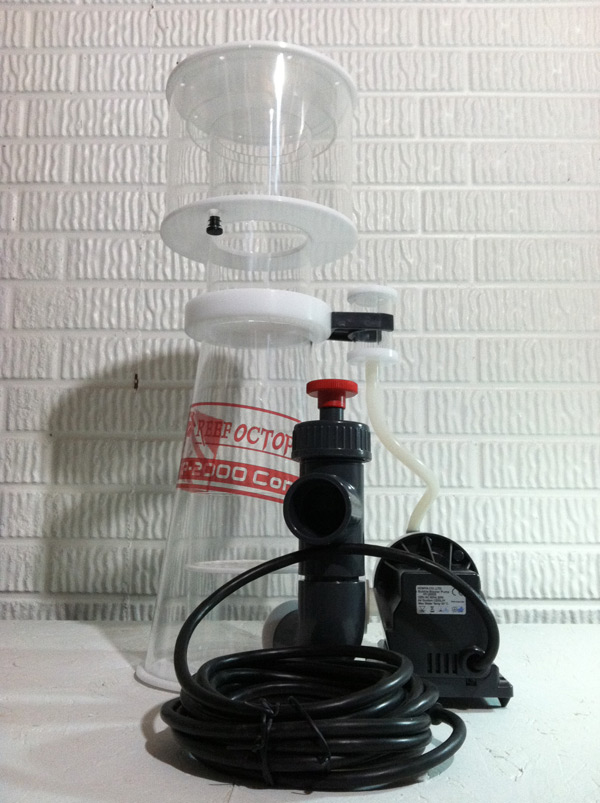Saltwater aquarium hobbyists today have a dizzying array of devices, doodads, and doohickeys at their disposal for improving water quality and maintaining appropriate water parameters. Some of these items are essential for aquarium success, while others might be more appropriately placed under the heading of “bells and whistles.”
High on the list of what we would consider vital gadgetry is the protein skimmer. This is one device we believe no saltwater system should be without. In fact, it’s possible to maintain a perfectly healthy marine aquarium relying on nothing more than a good protein skimmer, powerheads to provide vigorous water movement, a heater, appropriate lighting, quality live rock, and frequent partial water changes.
What is a protein skimmer?
In a nutshell (clamshell?), a protein skimmer is a device that mixes aquarium water with a large amount of very tiny air bubbles in a reaction chamber. As the bubbles rise up through the water column, molecules of dissolved organic compounds (DOCs) adhere to them and are carried to the top of the chamber where a thick foam begins to develop. The foam keeps building until it eventually reaches a collection cup, where it collapses into a tea-colored, foul-smelling liquid called skimmate. The skimmate is then eliminated whenever the hobbyist empties and rinses the collection cup in the sink.
Some protein skimmers are designed to sit in a sump below the tank, some are free-standing, others are intended to hang on the rim of the tank, and still others are designed to be placed inside the tank. There are also myriad variations on precisely how the water and air bubbles are mixed in the reaction chamber from one style of skimmer to the next.
Why is protein skimming so important?
Here at Saltwater Smarts, we don’t call the protein skimmer a “water-quality workhorse” for nothing! Here are the key advantages of using one:
- Eliminates DOCs before they decompose and are acted upon by nitrifying bacteria, thus easing the burden on your biofilter and slowing the buildup of nitrate
- Increases water clarity by removing yellowing compounds
- Maximizes dissolved oxygen levels
- Helps maintain a proper pH level by “driving off” carbon dioxide
- Denies troublesome algae a “fertilizer” source
Don’t skimp on your skimmer!
Keep in mind that not all protein skimmers are created equal. You don’t need to shell out for the most expensive skimmer on the market, but you shouldn’t skimp on your skimmer investment either. Get the best model you can reasonably afford, and consider purchasing one that is rated for a larger aquarium than the one you have (we use and recommend Coral Vue Octopus skimmers, such as the Super Reef and Needle Wheel). This will give you a greater margin of error as your stocking level increases and your specimens grow.




Hi I am a newbie on the salt water tank thing. I have a 30 gal tank which will get larger as I learn how to take care of it. I have a question and every saltwater place I ask gives me a different answer. I have a black plastic cover that goes down the back of my tank which covers the filter system and it has gotten a lot of white hard things on it. It looks almost like a kind of salt build up. I can’t take it off because it needs to be scrapped and I am afraid to damage the plastic wall. Everyone tells me to leave it and someday it will glow purple with the blue light on but it getting more and more on it. I just want to make sure it won’t hurt my tank. Hopefully you have seen this before a can tell me what this is. I have my water checked at least once a month and it is always testing good. Please help.
Jane Rodriguez
Hi Jane. We have a few ideas of what this might be, but it would be very helpful in making a determination if we could see a photo of the buildup in question. Would it be possible to post one to our Facebook page or email one to us?
Thank you I just posted a picture on face book for you. Couldn’t figure out how to get one on here.
Jane
I’ve firsthand dealt with skimmer blues. In fact i’ve gone through a good 4-5 skimmers on my 180 display tank. From what i can understand in the market here in the US is that most protein skimmers are over-rated on what they are “Spec’d at”. Hence a 180 gallon with a skimmer rated for up to 220 gallon tank is moreless pushing the capabilities of the skimmer. In essence it’s like buying a car with 200 hp and flooring it all day to get anywhere. Not very effective. Especially if you wish to feed your corals! That in itself creates a huge bioload most companies won’t take in for account on rating there product’s true abilities. With that said, I’ve always tried to tell people that if you want a skimmer that will be a product you won’t be regretting and later upgrading, get a skimmer rated double your tank’s water volume total.
Great insights, James! Thanks for your thoughts–and for being the first to comment on our new site. I too have experienced the undersized skimmer blues, so I can relate. A system’s protein skimmer is definitely not a good place to cut corners or skimp on costs, as it’ll just end up costing you more in the long run (much like reef lighting).